Considering that interest rates are still quite high and the inventory is still quite low, so many potential homebuyers found themselves obsessing over every single housing market sign of instability.
As a matter of fact, ever since the pandemic, plenty of real estate experts have been relentlessly waiting for the other shoe to drop, anticipating the next major crash that would potentially affect all aspects of the housing market.
So far, this hasn’t happened, and there are still high hopes that it won’t. The official 2025 housing forecast isn’t fully out until later in the year, but the high level of expectation would be that the housing market will fare much better in 2025.
And since it’s been almost five years since the start of the pandemic, which definitely affected the housing market, we are still taking a closer look at market indicators to spot whether or not a crash is on the horizon.

An updated review
A couple of key things affected the housing market when the pandemic hit in early 2020. First, most employees started working remotely. After many months of a new lifestyle like this, renters and homeowners decided they desired more space, both for their home offices but also for their backyards.
All these homeowners started buying or listing their current homes for sale, which caused a sudden boom in the market. However, the boom didn’t last for too long. In fact, shortly after, all the astronomical home prices caused the Federal Reserve to raise the mortgage interest rates.
Sky-high rates are still here to stay, and they have had a freeze effect on the market for two targeted categories: homeowners and prospective first-time buyers. That’s mainly because those who own a home are quite reluctant to sell, so all the potential homebuyers are still priced out of the market.
Nowadays, many experts believe that inventory levels are somehow balancing out, as home prices still trend back to normal. Still, interest rates are quite high. As 2024 started on a promising foot, since mortgage rates dropped in late 2023, that promise slowly faded as mortgage rates surged.
But as we get closer to the end of 2024, we are noticing mortgage rates decline once more. In fact, the mortgage rate decline is bound to continue, and 2025 will likely see improved home sales.
Will the market crash in 2025?
Most experts are on the same page when it comes to their predictions related to the market. They all think that it will continue to mark a correction that could benefit both buyers and sellers. However, first and foremost, they don’t foresee a crash, especially one as bad as the one in 2008.
The lessons that were learned from that time led to improved lending regulations, and they also have a stronger overall economy nowadays. Instead, what could happen, and I’m already foreseeing it, is that home pricing will probably stabilize, and the rapid price increases we’ve experienced in the last years will automatically flatten out.
Local variations could occur, which means that some markets could still experience rising home prices. It mainly depends on inventory levels, buyer demand and also local economies. According to Steve Nicastro, a Managing Editor at Clever Real Estate, there could be a potential cooling-off period with some small price declines.
The main reason for that is the fact that inventory is rising all over the nation, and now we have the most active listings on the market since pre-COVID.
Experts also think that inventory levels will keep on rising, especially as homeowners who locked in mortgage rates of 3 to 4% mark current rates dropping and start to feel increasingly more comfortable listing their homes and making the right move.
A closer look at interest rates
Experts agree on one thing: the downward trend in mortgage rates will definitely advance this year. As rates were once 7% on a 30-year fixed, they are somewhere around 6 to 6.5%. They could potentially fall into the 5% range in 2025, which would definitely support demand.
As the interest rate drops, homes could become more affordable to buyers. These factors will definitely impact the housing market and home prices. On top of everything, they’re also intertwined.
Mortgage interest rates are also expected to fall, especially as the Feds started cutting rates since the latest September meeting and they’ll potentially continue to do so at subsequent meetings. However, it’s worth noting that mortgage rates aren’t the only factor experts keep an eye on when it comes to signs of the market’s health.

Major indicators the experts look out for
When they assess the health of the housing market, experts pay increasingly more attention to interest rates, inflation, employment rates and also inventory levels. For example, higher interest rates could ultimately raise the final home purchase price. When you add in the higher interest payments, homebuyers pay more for a house than they’d have when the rates were much lower.
On a similar note, high inflation could negatively affect buyers’ purchasing strength. Lower unemployment rates tend to boost consumer confidence and also increase demand in the housing market. The reverse could also happen.
If the employment rates drop, consumer confidence could also drop, and the housing demand decreases. Ultimately, high inventory can easily drive prices down, as low inventory can increase it.
Housing affordability is one of the most important factors for the median home buyer, and mortgage rates, incomes, and home prices are a trio of the most important factors that ultimately shape affordability. Rising incomes have been an increasingly positive factor for housing affordability, but it’s still not enough to completely offset the sting of higher home prices and mortgage rates.
From now onward, incomes might not catch up with the speed of the economy’s downshifts, so all this tailwind could shift to a headwind. However, mortgage rates are still expected to provide a boost to homebuyer purchasing power, especially after a period of drag.
The increase in supply also helped slow time on the market, which is still faster than what was typical before the pandemic. On a nationwide level, homes were on the market for 7 days longer than one year prior.
On top of that, data shows that for every 5.5 percentage point increase in active listings in a market, the number of days increased by one day. What does this mean? Well, it gives shoppers more time to make the right decision and is especially valuable for first-time shoppers who try to navigate a purchase decision.
What happens next?
Experts think that many parts of the country will keep noticing price corrections as mortgage rates drop. As a general rule, markets that noticed significant price increases during the pandemic, like Austin, Phoenix, and Raleigh, are way more vulnerable to price corrections, especially since supply increases and demand softens.
On the other hand, lower-priced markets that didn’t mark any dramatic price surges, as well as those that benefit from strong employment and favorable demographics are way more likely to perform more steadily.
Moreover, if you are preparing to list your own home, th best thing to do is to rely on what your estate agent says when it comes to pricing.
If you found this article useful, we also recommend checking 5 Conversations You Should Have With a Terminally Ill Loved One









